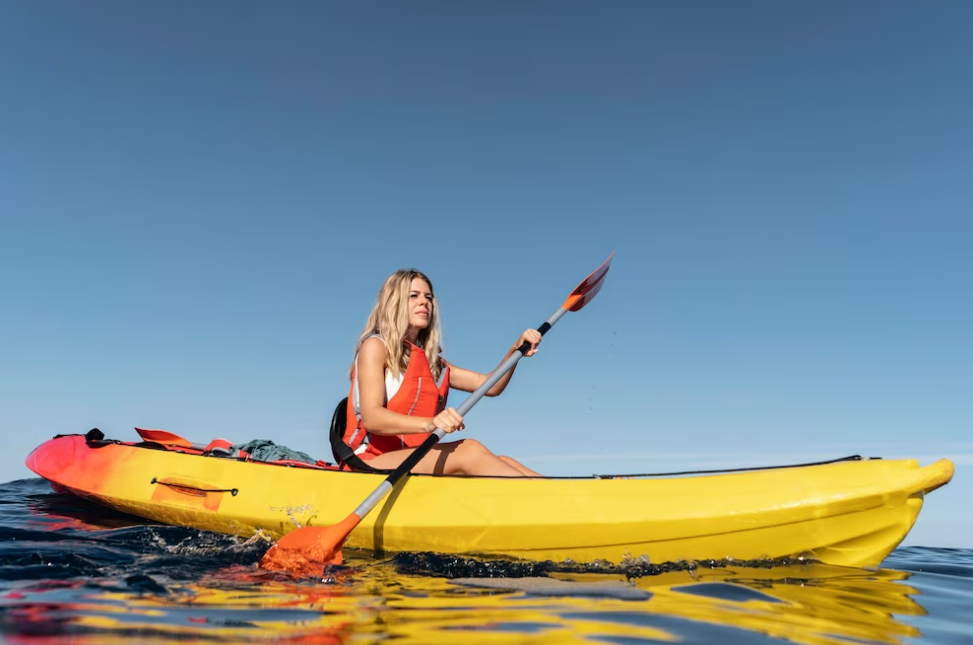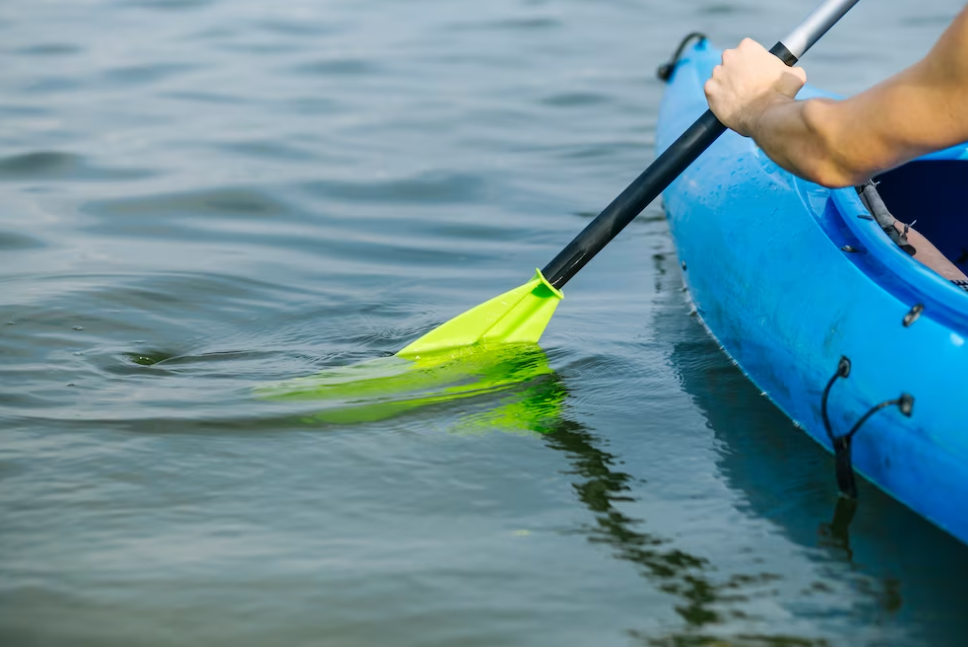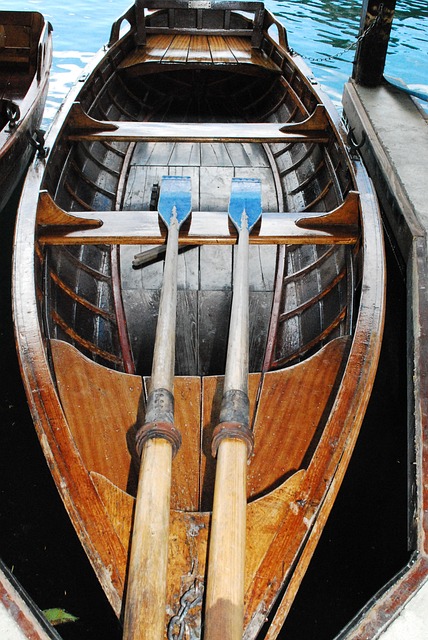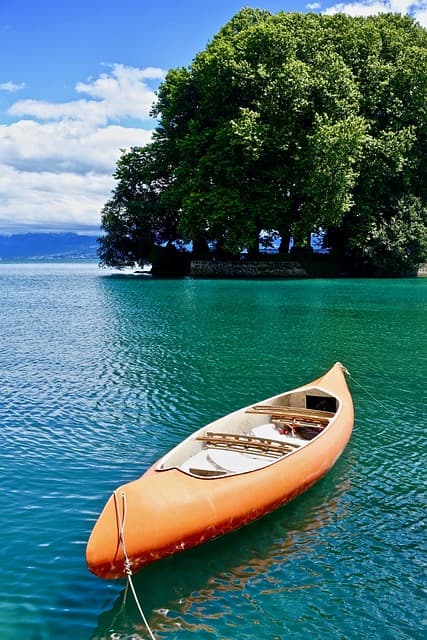The significance of selecting the appropriate kayak paddle size often escapes new paddlers. Yet, the right dimensions can entirely transform your on-water experience. Determining the correct size for your kayak paddle is a question many ask. Generally, a 230 cm paddle suits average-sized kayakers, particularly those embracing a low-angle, relaxed technique. For a more dynamic, high-angle approach, paddlers tend to favor a 220 cm or 210 cm paddle with sturdy blades.
The ideal size remains somewhat subjective. Nonetheless, precision is vital. An excessively lengthy paddle results in added strain on your shoulders and torso, while one that’s too short might lead to your kayak’s sides being grazed with each stroke. Naturally, the specific kayak paddle size hinges largely on your torso height and kayak width. As you journey through this article, we’ll equip you with the knowledge required to determine the perfect paddle size tailored to your needs.
Why Paddling Style Matters in Paddle Sizing
Understanding the nuances of paddle sizing goes beyond mere numerical values; it’s a delicate balance that takes into account various elements, with paddling style emerging as a critical factor. Your paddling style has a profound impact on the ideal size for your kayaking adventures. Whether you’re inclined towards the low-angle approach, characterized by relaxed and steady strokes, or the high-angle technique that exudes power and speed, each style necessitates a distinct paddle size to optimize your performance on the water.
For those who lean towards the low-angle style, a longer extension tends to be more suitable. This is because the low-angle technique involves less forceful movements, with the blade slightly tilted relative to the water’s surface. The extended reach provides enhanced coverage, ensuring efficiency while maintaining a comfortable posture. On the other hand, the high-angle style, characterized by an upright posture and dynamic, forceful motions, demands a shorter extension. This length allows for quick, forceful actions without overexertion, facilitating precise maneuvering and efficient acceleration.
Discovering the right size that aligns with your preferred approach can significantly impact your overall experience. An appropriately fitted extension complements your technique, minimizing strain on your body and optimizing efficiency. Neglecting this vital aspect could lead to discomfort, fatigue, and even underperformance. It’s crucial to recognize that size isn’t merely a numerical guideline but a tailored component that harmonizes with your chosen style.
What’s the Appropriate Kayak Paddle Size in Inches?
Determining the correct kayak paddle size in inches is a fundamental consideration for a comfortable and efficient paddling experience. It’s essential to match the paddle length to your specific needs, taking into account factors such as your paddling style, kayak width, and your own height or torso measurement. The right size ensures optimal stroke efficiency, reduced strain on your body, and enhanced maneuverability on the water. Whether you’re a novice kayaker or an experienced enthusiast, selecting the appropriate paddle size in inches is a crucial step toward maximizing your enjoyment and performance while navigating the waterways.
Let’s start with the basics. Irrespective of your location or measurement system preference, kayak paddles are universally measured in centimeters (cm), not inches. Whether you step into a store in the US, UK, Canada, or elsewhere, the conversation revolves around kayak paddle size in terms of centimeters—cm.
For those who still prefer the Imperial system, here’s a handy kayak paddle sizing chart to offer you a visual representation of lengths in inches.
Conversion of Paddle Lengths to Inches:
| Kayak Paddle Size (cm) | Kayak Paddle Length (inches) |
|---|---|
| 250 cm | 98.4″ |
| 240 cm | 94.5″ |
| 230 cm | 90.5″ |
| 220 cm | 86.6″ |
| 210 cm | 82.7″ |
| 200 cm | 78.7″ |
| 190 cm | 74.8″ |
| 180 cm | 70.9″ |
Observe that with each 10cm increment change in kayak paddle length, you’ll experience a shift of around 2 inches at each end of the paddle. Although this might not appear significantly different, the repercussions of using a slightly mid-sized can multiply over the course of thousands of strokes during an extended kayaking expedition. Over time, these inefficiencies can accumulate and lead to quicker fatigue.
Efficient Techniques for Swift Kayak Paddle Sizing
Explore efficient and dependable techniques designed to unveil the ideal kayak paddle size swiftly. These methods prove especially advantageous when time is at a premium. Employ both strategies if you find yourself in doubt regarding the precise size of a kayak paddle, whether it’s in your possession or borrowed from someone else. These strategies are invaluable in situations where a quick and accurate determination of paddle size is necessary, enhancing your overall kayaking experience.
Quick Kayak Paddle Sizing
- Extend your arms forward, with elbows at a 90-degree angle, simulating the regular paddling stance. Grasp the paddle with both hands, positioning them around 2/3 of the distance from the paddle’s center to the blade’s shoulder (where the blade connects to the shaft);
- Place the paddle vertically beside you. Raise your arm completely, allowing the first joint of your fingers to envelop the paddle blade’s tip. Ensure that you can encircle only a single finger joint – neither more nor less. If either condition is not met, consider opting for a longer or shorter size.
Matching Your Stroke: Paddle Sizing and Paddling Technique

Two clear-cut styles of kayak paddling exist:
- Low Angle – Employing low angle strokes involves a paddle slightly inclined relative to the water’s surface. For the average-height, low angle recreational paddler, a 230 cm kayak paddle is recommended;
- High Angle – High angle strokes entail tilting the paddle more vertically in relation to the water’s surface. The average-height, high angle recreational paddler typically benefits from a kayak paddle ranging between 210 cm and 220 cm.
Low Angle = Longer Paddle
Opting for a low angle paddling technique typically involves a more relaxed and leisurely cadence. This style is commonly embraced during recreational and touring kayaking ventures. It offers an enjoyable experience, places minimal strain on your shoulders, and mitigates exhaustion during lengthy touring excursions.
Nonetheless, a drawback of this approach is the risk of scraping your kayak’s side with each paddle stroke unless you possess an appropriately sized kayak paddle. Additionally, it can result in a zig-zag tracking pattern as you paddle. This is why a slightly longer kayak paddle size is preferable for a low angle paddling style.
High Angle = Shorter Paddle
In contrast, high angle paddling embodies a vigorous and accelerated technique. It’s primarily employed to swiftly propel your kayak with intensity.
Opt for a shorter kayak paddle size if you favor vigorous paddling with a rapid cadence. This choice will be gentler on your shoulders and reduce the occurrence of zig-zag movements.
Guidelines for Selecting the Right Kayak Paddle Size
Initiating our exploration with a foundational framework rooted in low-angle kayak paddle sizing, we lay the groundwork for a comprehensive understanding. As we delve into the intricacies, our focus sharpens, enabling us to meticulously tailor the kayak paddle size to harmonize with your individual needs. In essence, the kayak paddle’s length finds its equilibrium through the synergy of two pivotal measurements:
- Kayak Width – The expanse of your kayak wields influence, dictating the requisite length of your paddle. A kayak with greater width commands a longer paddle size to ensure optimal paddling efficiency;
- Your Height – The canvas of your physical stature interlaces with paddle size determination. Your height substantiates a crucial factor, serving as a compass to navigate towards the paddle length best suited for your comfort and performance.
Guide to Sizing Your Kayak Paddle for Low Angle Paddling
Refer to this paddle sizing guide if you own a recreational, touring, or fishing kayak and prefer a low-angle paddling technique.
| Kayak Width | Under 24″ | 24″ to 28″ | 29″ to 33″ | Over 33″ |
| Paddler Height | Paddle Length | Paddle Length | Paddle Length | Paddle Length |
| 5’0″ or less | 210cm | 220cm | 230cm | 240cm |
| 5′ – 5’6″ | 215cm | 220cm | 230cm | 240cm |
| 5’6″ – 6′ | 220cm | 220cm | 230cm | 250cm |
| 6′ or more | 220cm | 230cm | 240cm | 250cm |
Sizing Your Kayak Paddle in High Angle Style
Refer to this paddle sizing guide if you own a touring or sea kayak and prefer a high-angle paddling technique.
| Kayak Width | 17″ to 23″ | 23″ to 25″ | Over 25″ |
| Paddler Height | Paddle Length | Paddle Length | Paddle Length |
| 5’0″ or less | 200cm | 210cm | 220cm |
| 5’0″ – 5’6″ | 210cm | 220cm | 230cm |
| 5’6″ – 6’2″ | 220cm | 230cm | 240cm |
| Over 6’3″ | 230cm | 240cm | 250cm |
Whitewater Kayak Paddle Size Reference
Wondering about the appropriate size for your whitewater kayak paddle? Consult this paddle sizing guide if you own a recreational, touring, or fishing kayak and prefer a low-angle paddling style.
| Paddler Height | Paddle Length |
|---|---|
| Under 5’2″ | 188cm – 194cm |
| 5’2″ – 5’8″ | 190cm – 196cm |
| 5’8″ – 6’1″ | 192cm – 200cm |
| Under 6’1″ | 196cm – 204cm |
Guide to Kayak Paddle Sizing Based on Torso Height
When it comes to sizing a kayak paddle, the realm of individuality extends far beyond mere numerical measurements. Each person’s physique boasts its own distinct configuration, with height distribution being just one facet. Some individuals might find their height concentrated in their legs, resulting in a taller stance when measured overall. Conversely, another person might exhibit a height profile predominantly residing in their torso, despite appearing shorter overall.
Fascinatingly, the world of kayak paddle sizing presents a revelation: it’s your torso height that truly holds the key to precision. In this dynamic interplay of body dimensions, the measurement of your torso height emerges as a remarkably accurate determinant, surpassing the more general indicator of overall height.

Your torso height measurement, taken while seated, spans from the crotch to the tip of your nose. This seemingly niche metric, however, bears profound significance in the world of paddling. Its influence extends beyond numbers, affecting the very mechanics of your paddle strokes. The height of your torso governs the elevation of your arms relative to the kayak’s sides, playing a pivotal role in your paddling technique’s efficiency and comfort. By honing in on this particular measurement, you’re aligning your paddle’s size with your body’s interaction with the kayak, creating a harmonious synchronization that enhances both your prowess and enjoyment on the water. So, as you delve into the science of paddle sizing, remember that it’s not just about numbers—it’s about translating your unique physique into an artful harmony with the kayak and the water.
| Torso Height | High Angle Paddling | Low Angle Paddling |
|---|---|---|
| 24″-28″ | 210cm – 215cm | 215cm – 220cm |
| 28″-30″ | 220cm – 230cm | 230cm |
| Over 30″ | 230cm | 230cm |
Illustration of Kayak Paddle Sizing
Utilize the aforementioned guides to deduce the appropriate kayak paddle size for your needs. Gauge your height, your kayak’s width, and your torso height. Then, consult each sizing guide to pinpoint the consistent paddle size aligning with your specific measurements.
For instance, let’s consider my case: I stand at 5’9″, own a 29″ wide kayak, possess a torso height of 30″, and engage in recreational low-angle paddling. The shared value across these measurements suggests that a 230 cm paddle suits me best. Notably, this choice precisely matches the paddle size I utilize.
Remarkably, this alignment corresponds with the same “average” paddle size of 230 cm, which we initially highlighted in the early sections of this article.
Hands-On Approach to Determining Kayak Paddle Size
Much akin to the meticulous process of determining other fundamental kayak measurements like length, width, and volume, sizing a kayak paddle thrives when immersed in a hands-on experience within the very vessel you’ll be navigating. Seated within your kayak, engaging in trial and error with an assortment of paddle sizes, unveils a treasure trove of valuable insights. This direct interaction enables you to discern the nuances that contribute to a well-fitted paddle.
When you step into the realm of reputable kayak shops, you tap into a wellspring of expertise ready to expediently discern the paddle size that best complements your requirements. These knowledgeable establishments extend a valuable opportunity: a hands-on trial. Placing you in a kayak and offering a selection of paddle sizes for experimentation, they empower you to pinpoint the size that promises not only comfort but also optimal performance.
Yet, beyond mere size considerations, a visit to a specialized kayak shop holds yet another incentive. Their keen eye is attuned to detecting any inadvertent paddling habits that could hinder your experience. Acquiring the right-sized paddle is only part of the equation; aligning it with your technique is equally imperative. With their guidance, you ensure that every stroke you make is supported by an appropriate paddle size and a refined paddling technique, harmonizing comfort and efficiency in your aquatic endeavors.
Conclusion
In the realm of kayaking, paddle sizing emerges as a critical touchstone for optimal performance. This comprehensive guide has meticulously navigated the intricacies of paddle selection, from understanding paddling styles to embracing body proportions and kayak specifications. Armed with this knowledge, you’re primed to embark on your ventures with confidence and comfort. As your paddle seamlessly integrates with your technique and physique, every stroke becomes an expression of your connection with the water. With this guide as your compass, may your kayaking journeys be marked by precision, enjoyment, and a profound communion with the aquatic world.



